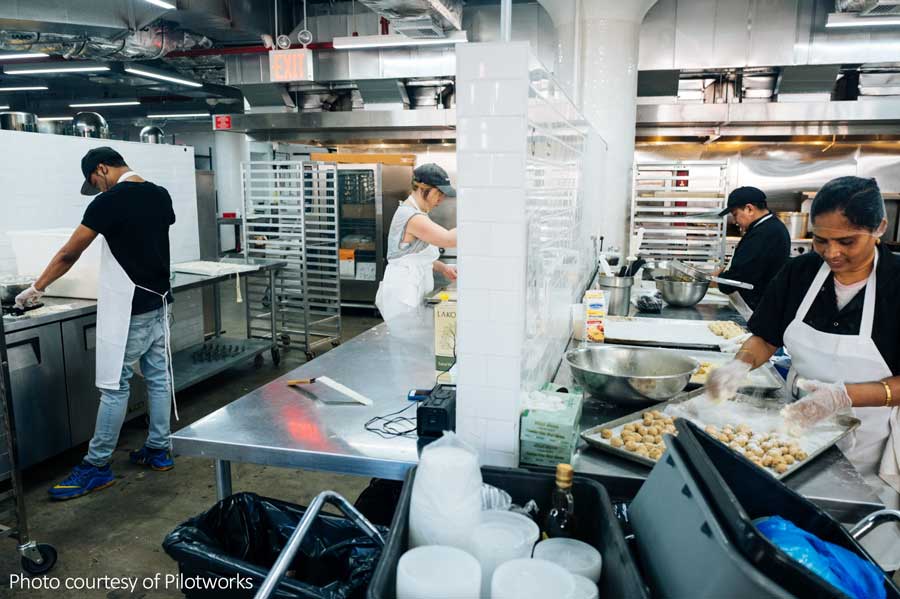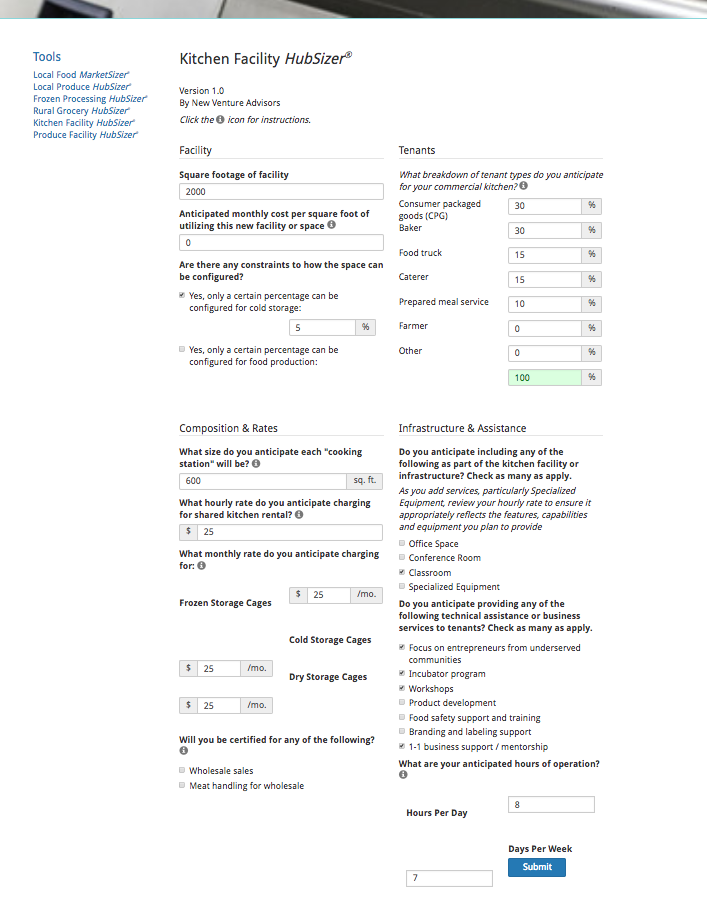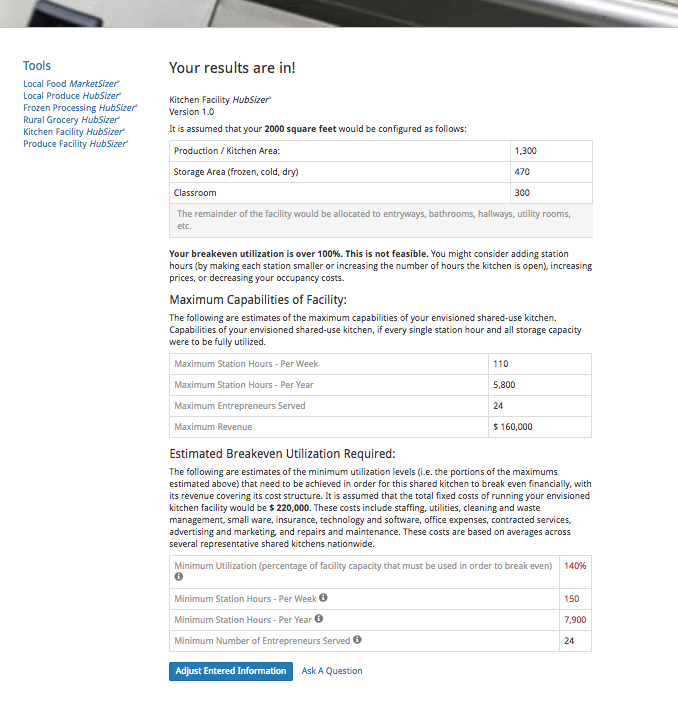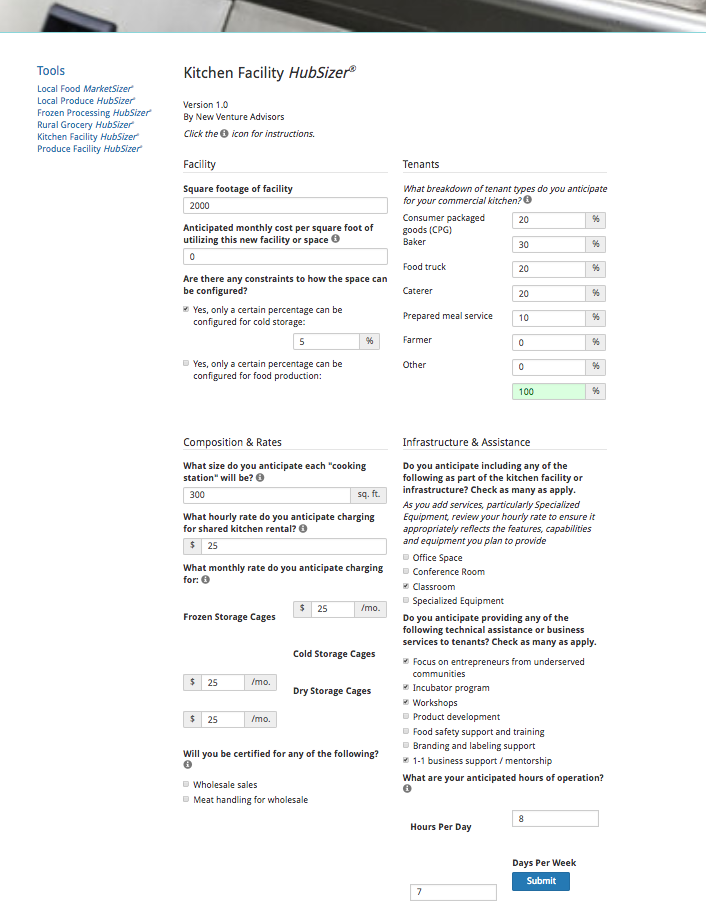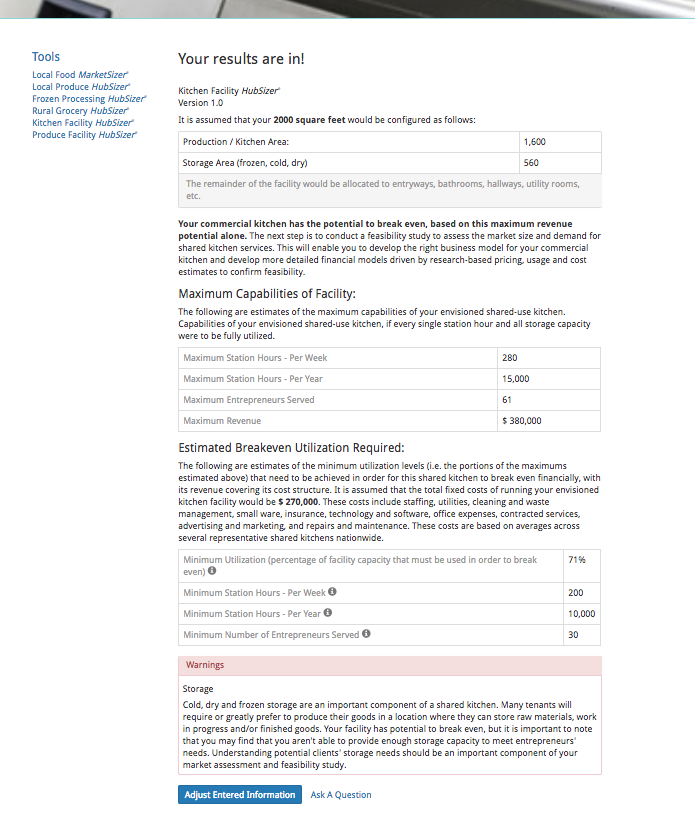A microblog series on the HubSizer® and MarketSizer® tools from New Venture Advisors.
Do you own or have access to an entire building, space or business and want to convert it into a commercial kitchen or food business incubator but are not sure where to start? Today we’ll show you how to use the Kitchen Facility HubSizer® tool to do just that! This tool is designed to help anyone who has access to a site or space within a site, and wants to assess the potential of that space to be used as a shared-use kitchen. The Kitchen Facility HubSizer® estimates the capacity and breakeven utilization for a commercial kitchen or kitchen incubator built out in an existing facility.
Today we’ll take you through an illustrative example that is broadly inspired by previous projects we’ve worked on.
A Native American-focused nonprofit organization in Colorado is interested in repurposing extra space in their Community Center. Previously, the Community Center had a kitchen used by an after-school program and summer camp to prepare meals for kids. These programs recently moved to a new facility and now the kitchen is unused. The Community Center staff want to explore a new purpose for the kitchen—could they use it to further their Center’s mission in providing services and economic development opportunities to native, indigenous, community members? They are interested in allowing locally owned food businesses and aspiring entrepreneurs to rent out the kitchen and hosting cooking classes, but can they afford to offer such services within their budget? Can a program like this earn enough revenue to cover its costs?
The Kitchen Facility HubSizer® tool can answer many of these initial questions and provide a baseline understanding of what’s possible. Let’s walk through their scenario to find out.
They enter the NVA Toolsite and click on the Kitchen Facility HubSizer® tool. They navigate to the data entry page and input their estimates for the Community Center’s kitchen, shown in the screenshot below:
The kitchen in the Community Center is 2,000 square feet. The staff estimate that only 5% of this space could be used for cold storage (since the previous users took the coolers when they moved out), that a cooking station would be 600 square feet and that they’d charge $25 per hour to rent the stations and all the storage cages. The Center knows that members of their community have side businesses baking, canning vegetables and producing jams, so they estimate that 30% of clients will represent these two categories. The Center is outside of Colorado Springs where there is a burgeoning food truck scene, so they estimate that 15% of clients will be food trucks. They estimate that of the remaining clients, 15% will be caterers (mostly serving the Center itself) and 10% will make prepared meals. The Center is eager to inspire members of their community to launch a food business, so it indicates plans to provide technical assistance, create an incubator program, provide business workshops and eventually offer 1:1 business mentorship.
The Center believes that at least early on, most potential clients would be selling through farmers markets and other direct-to-consumer channels, so keeps “wholesale” and “meat handling” boxes unchecked. The Center also has an adjoining classroom space off the kitchen. Finally, the Center is already staffed 7 days a week and on weekends by an existing staff member—so they input those final numbers and hit Submit!
The results show how the kitchen is assumed to be configured. However, it includes the classroom space which is actually not part of the 2,000 square foot kitchen—woops! The breakeven utilization shows a number over 100% which is not feasible.
The tool suggests a few reasons why break even may not be feasible—either they need to charge more per hour, increase the number of cooking stations (i.e. the amount of food businesses that can work side by side in the kitchen), or decrease occupancy costs. The Community Center is not willing to charge more because they want to make sure the kitchen is affordable for clients, and $25 per hour is already on the highest end of what they believe their members could pay. They can’t decrease occupancy costs (as they assumed $0 in rent!) but they certainly could redesign the kitchen to add equipment enabling them to add stations, making each station smaller than their original 600 square feet estimate.
They click Adjust Entered Information.
Back in the entry fields, they update the size of the stations from 600 square feet to 300 square feet (still a generous amount of space for food prep). The Community Center also decides to change the types of tenants they will attract to provide a more regular and frequent stream of business. They increase the percentage of food trucks and catering clients and decrease the percentage of value-added producers who may reserve the kitchen just once or twice a year to make a batch of product. The Center also unchecks the classroom tab so it won’t be included in the overall square footage of the kitchen.
They hit Submit and see the new results…
With these new inputs, the results show that a commercial shared-use kitchen in the Community Center has the potential to break even! The tool estimates the kitchen’s fixed costs to be $270,000 per year. (Originally, this number seemed high to the Center but as they thought about it more, they realized just how labor intensive the various services they wanted to provide will be: technical assistance, 1-1 business support etc. all will require an increased level of staffing.) In order to break even, the Community Center’s kitchen would need to rent out 200 station hours a week or 10,000 station hours over the course of the year, achieving a 71% utilization rate. A few things to understand here: the utilization rate (71%) is high and may be tough to achieve, especially within the first year as the kitchen builds up its client base. One of the most important numbers for them to evaluate is that 30 clients would have to be engaged to break even. In thinking about the size of the Native American population served by the Community Center, and the amount of food-focused businesses within this population, there may be some doubt that these client levels can be achieved. Perhaps this means the Community Center should aim to ensure 50% of clients come from the primary population of focus, but that they should also open up their kitchen to other food businesses in and around the Colorado Springs area. They also might want to evaluate what might happen if they reduced some of the secondary services they intend to provide, to make the program more manageable and cost effective.
Also, a warning box in the tool flags a major constraint for the kitchen: its lack of storage space. Cold, dry and frozen storage is an important feature of a shared kitchen, as many clients will need it to run their businesses out of a shared kitchen space. It will be important for the Community Center to adjust their numbers and/or solve for this limitation in the future.
Finally, it should be said that many commercial kitchens choose to operate as partially grant-funded entities without breaking even, due to the types of clients they want to serve and the mission of their facility. This, of course, is a perfectly acceptable model as well! The Kitchen Facility HubSizer® tool is only meant to paint a high level picture of what the break even capabilities could be given a set of inputs. Needless to say, this Colorado Community Center can be well on its way to further exploring and building up these capabilities, thanks to insights from the tool.
(Photo courtesy of Pilotworks)
Next week, our *LAST* microblog in the series showcases the Frozen Processing HubSizer® and how to analyze the types of frozen produce processing services a facility should/can offer.

